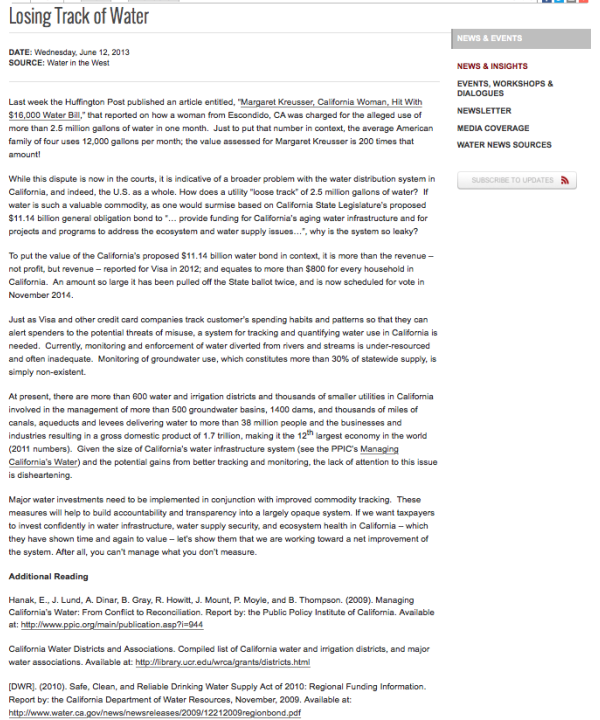June 12, 2013 | Water in the West | Insights
Last week the Huffington Post published an article entitled, “Margaret Kreusser, California Woman, Hit With $16,000 Water Bill,” that reported on how a woman from Escondido, CA was charged for the alleged use of more than 2.5 million gallons of water in one month. Just to put that number in context, the average American family of four uses 12,000 gallons per month; the value assessed for Margaret Kreusser is 200 times that amount!
While this dispute is now in the courts, it is indicative of a broader problem with the water distribution system in California, and indeed, the U.S. as a whole. How does a utility “loose track” of 2.5 million gallons of water? If water is such a valuable commodity, as one would surmise based on California State Legislature’s proposed $11.14 billion general obligation bond to “… provide funding for California’s aging water infrastructure and for projects and programs to address the ecosystem and water supply issues…”, why is the system so leaky?
To put the value of the California’s proposed $11.14 billion water bond in context, it is more than the revenue – not profit, but revenue – reported for Visa in 2012; and equates to more than $800 for every household in California. An amount so large it has been pulled off the State ballot twice, and is now scheduled for vote in November 2014.
Just as Visa and other credit card companies track customer’s spending habits and patterns so that they can alert spenders to the potential threats of misuse, a system for tracking and quantifying water use in California is needed. Currently, monitoring and enforcement of water diverted from rivers and streams is under-resourced and often inadequate. Monitoring of groundwater use, which constitutes more than 30% of statewide supply, is simply non-existent.
At present, there are more than 600 water and irrigation districts and thousands of smaller utilities in California involved in the management of more than 500 groundwater basins, 1400 dams, and thousands of miles of canals, aqueducts and levees delivering water to more than 38 million people and the businesses and industries resulting in a gross domestic product of 1.7 trillion, making it the 12th largest economy in the world (2011 numbers). Given the size of California’s water infrastructure system (see the PPIC’s Managing California’s Water) and the potential gains from better tracking and monitoring, the lack of attention to this issue is disheartening.
Major water investments need to be implemented in conjunction with improved commodity tracking. These measures will help to build accountability and transparency into a largely opaque system. If we want taxpayers to invest confidently in water infrastructure, water supply security, and ecosystem health in California – which they have shown time and again to value – let’s show them that we are working toward a net improvement of the system. After all, you can’t manage what you don’t measure.
Additional Reading
Hanak, E., J. Lund, A. Dinar, B. Gray, R. Howitt, J. Mount, P. Moyle, and B. Thompson. (2009). Managing California’s Water: From Conflict to Reconciliation. Report by: the Public Policy Institute of California. Available at: http://www.ppic.org/main/publication.asp?i=944
California Water Districts and Associations. Compiled list of California water and irrigation districts, and major water associations. Available at: http://library.ucr.edu/wrca/grants/districts.html
[DWR]. (2010). Safe, Clean, and Reliable Drinking Water Supply Act of 2010: Regional Funding Information. Report by: the California Department of Water Resources, November, 2009. Available at: http://www.water.ca.gov/news/newsreleases/2009/12212009regionbond.pdf
By Tara Moran and Andrew Fahlund


![[Woods Logo]](/sites/default/files/logos/footer-logo-woods.png)
![[Bill Lane Center Logo]](/sites/default/files/logos/footer-logo-billlane.png)